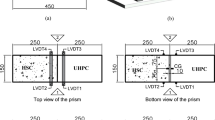Abstract
This paper presents basic information on the mechanical properties of steel fibre-reinforced light-weight concrete, manufactured using pumice stone or expanded clay aggregates. Results are presented for standard compressive tests and indirect tensile tests (splitting tests on cylinder specimens and flexure tests on prismatic beams using a three-point loading arrangement) under monotonically increasing or cyclically varying loads. The influence of steel fibres and aggregate types on modulus of elasticity, compressive and tensile strength and post-peak behaviour is evaluated. Test results show that compressive strength does not change for pumice stone aggregates, while an increase is observed for expanded clay; tensile strength and fracture toughness are significantly improved for both pumice stone and expanded clay. The results also show that with both expanded clay and pumice stone lightweight aggregates a suitable content of fibres allows one to obtain performances comparable with those expected from normal weight concrete, the important advantage of lower structural weight being maintained.
Résumé
Cet article présente des informations de base sur le comportement mécanique des bétons légers fabriqués avec des granulats d’argile expansé et de ponce renforcés de fibres d’acier. En particulier, on présente les résultats d’essais de compression et de traction indirecte (essais par fendage et essais de flexion sur de petites poutres prismatiques appuyées aux extrémités et chargées dans la section médiane). Les essais ont été réalisés en agissant sous contrôle des déformations et en imposant des histoires de déformations monotoniques et cycliques. L’étude a montré l’influence des divers pourcentages de fibres et du type de granulat léger sur le comportement mécanique du béton, en particulier sur le module d’élasticité en compression et sur la résistance maximum en compression et en traction. Les résultats des essais ont montré que l’ajout des fibres au béton comportant des granulats de ponce ne produit pas de variation de la résistance maximum à la compression. En revanche, l’introduction des fibres dans le béton avec granulats d’argile expansé entraîne une augmentation significative de la résistance maximale à la compression. Pour les deux bétons, on constate que l’ajout des fibres augmente la résistance à la traction et la ténacité en flexion. L’introduction des fibres d’acier dans tous les bétons légers testés donne au matériau des prestations élevées certainement comparables à celles des bétons normaux, mais avec les avantages évidents liés à un poids inférieur.
Similar content being viewed by others
References
Campione, G., La Mendola, L. and Miraglia, N., ‘Behaviour in compression of lightweight fibre reinforced concrete with pumice stone’, (available only in Italian), Proceedings of National Congress Giornate AICAP 99, Torino, Nov. 1999, 1 17–26.
Campione, G., Mindess, S. and Zingone, G., ‘Compressive stress-strain behavior of normal and high-strength carbon-fibre concrete reinforced with steel spirals’,ACI Materials Journal 96 (1) (1999) 27–34.
Balaguru, P. and Foden, A., ‘Properties of fibre reinforced structural lightweight concrete’,ACI Structural Journal 93 (1) (1996) 62–77.
ACI Committe 544, ‘Design considerations for steel fibre reinforced concrete’,ACI Structural Journal 85 (5) (1988) 563–580.
UNI 6130 Requirements, ‘Concrete specimens for strength tests—Shape and size of the specimens—Part I, (available only in Italian).
Eurocode 2, Design of Concrete Structures, Part 1, General rules and rules for buildings (UNI ENV 1992-1-1), december 1991.
Rocco, C., Guinea, G. V., Planas, J. and Elices, M., ‘Size effect and boundary conditions in the Brasilian test: theoretical analysis’,Mater. Struct. 32 (220) (1999) 437–444.
Banthia, N. and Trottier, J. F., ‘Test Methods for flexural toughness characterisation of fibre reinforced concrete: some concerns and a proposition’,ACI Materials Journal 92 (1) (1995) 48–57.
Schumm, C. and Gambarova, P. G., ‘On three-point bending tests on concretes and mortars reinforced with PAN fibres’, (available only in Italian),Studi e Ricerche Scuola di Specializzazione in Costruzioni in C.A. Fratelli Pesenti 12 (1990) 175–186.
ASTM C 1018, ‘Standard test method for flexural toughness and first crack strength of fibre reinforced concrete (Using beam with third-point loading)’, American Society of Testing and Materials, Philadelphia, Annual Book of Standard 4.02 (1994) 509–516.
Japan Society of Civil Engineers, ‘Method of tests for flexural strength and flexural toughness of fibre reinforced concrete’, Concrete Library of JSCE 3 Standard SF-4 (1984) 58–66.
Zhang, M. and Gjørv, O. E., ‘Mechanical properties of high-strength lightweight concrete’,ACI Material Journal 88 (3) (1988) 240–247.
Banthia, N. and Trottier, J., ‘Concrete reinforced deformed steel fibers, part I: Bond-slip mechanisms’,ACI Material Journal 91 (5) (1994) 435–446.
Gao, J., Sun, W. and Morino, K., ‘Mechanical properties of steel fiber-reinforced, high-strength, lightweight concrete’,Cement and Concrete Composites 19 (1997) 307–313.
Swamy, R. N., Jones, R. and Chiam, A. T. P., ‘Influence of steel fibers on the shear resistance of lightweight concrete I-beams’,ACI Structural Journal 90 (1) (1993) 103–114.
Zingone, G., Papia, M. and Campione, G., ‘Mechanical characterisation of fibre reinforced concrete by pull-out tests of single fibres’, Extending performance of concrete structures, Proceedings of International Congress Creating with Concrete, Dundee, Scotland, Sept. 1999, 229–237.
Campione, G., Miraglia, N. and Papia, M., ‘Experimental investigation on lightweight fibre reinforced concrete with hooked steel fibres’, RILEM Symposium BEFIB 2000, Lyon, Sept. 2000, 481–490.
Author information
Authors and Affiliations
Rights and permissions
About this article
Cite this article
Campione, G., Miraglia, N. & Papia, M. Mechanical properties of steel fibre reinforced lightweight concrete with pumice stone or expanded clay aggregates. Mat. Struct. 34, 201–210 (2001). https://doi.org/10.1007/BF02480589
Received:
Accepted:
Issue Date:
DOI: https://doi.org/10.1007/BF02480589




